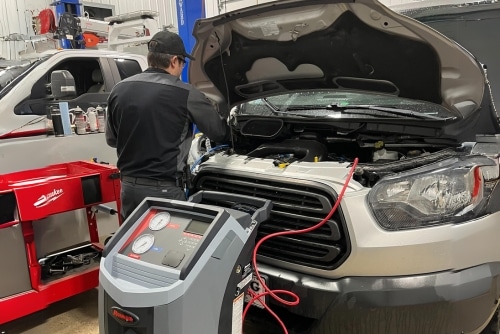Understanding the Mechanics of Automotive AC
Introduction to Automotive Air Conditioning
Automotive air conditioning (AC) systems have become an indispensable feature in modern vehicles, providing comfort and convenience to passengers, especially during hot summer days. Understanding the mechanics behind automotive AC systems can help drivers and technicians maintain and troubleshoot them effectively.

The Components of an Automotive AC System
1. Compressor
The compressor is the heart of the AC system. It is responsible for pressurizing and circulating the refrigerant, typically a substance like R134a or R1234yf, throughout the system. The compressor is usually driven by the engine via a belt or, in some newer vehicles, by an electric motor.
2. Condenser
The condenser is located at the front of the vehicle, usually in front of the radiator. Its primary function is to dissipate heat from the hot, pressurized refrigerant, causing it to condense into a liquid state. This liquid refrigerant then flows to the expansion valve or orifice tube.
3. Evaporator
The evaporator is located inside the passenger compartment, typically behind the dashboard. As the liquid refrigerant enters the evaporator, it undergoes a phase change from liquid to vapor, absorbing heat from the surrounding air in the process. This cooled air is then blown into the cabin by the blower motor and through the vents. Find more about us here.
4. Expansion Valve or Orifice Tube
The expansion valve or orifice tube regulates the flow of refrigerant into the evaporator. It controls the pressure and temperature of the refrigerant entering the evaporator, ensuring optimal cooling performance.
5. Receiver/Dryer or Accumulator
The receiver/dryer (for systems with an expansion valve) or accumulator (for systems with an orifice tube) serves as a storage reservoir for the refrigerant. It also contains a desiccant or drying agent to remove moisture from the system, which can cause corrosion and impair performance.
6. Refrigerant
Refrigerant is the substance that circulates through the AC system, absorbing and releasing heat to facilitate the cooling process. Over the years, automotive AC systems have transitioned from using environmentally harmful refrigerants like R12 to more eco-friendly alternatives like R134a and R1234yf.
How Automotive AC Systems Work
The operation of an automotive AC system involves a continuous cycle of compression, condensation, expansion, and evaporation. Here’s a simplified overview:
- The compressor pressurizes the gaseous refrigerant, raising its temperature.
- The hot, pressurized refrigerant flows to the condenser, where it releases heat and condenses into a liquid.
- The liquid refrigerant passes through the expansion valve or orifice tube, where its pressure and temperature drop.
- The low-pressure, low-temperature refrigerant enters the evaporator, where it absorbs heat from the surrounding air, cooling it in the process.
- The cooled air is blown into the cabin, providing comfort to the occupants.
- The refrigerant returns to the compressor to restart the cycle.
Maintaining Your Automotive AC System
Proper maintenance is essential for ensuring the optimal performance and longevity of your vehicle’s AC system. Here are some tips:
- Regularly inspect and replace the cabin air filter to ensure proper airflow.
- Check for refrigerant leaks and have them repaired promptly to prevent loss of cooling efficiency.
- Periodically clean the condenser and evaporator coils to remove dirt and debris that can obstruct airflow.
- Have your AC system serviced by a qualified technician at least once a year to check for any issues and recharge the refrigerant if necessary.
Conclusion
Understanding the mechanics of automotive AC systems can help drivers appreciate the technology behind this essential comfort feature in modern vehicles. By knowing how the various components work together to provide cooling, drivers can better maintain their AC systems and address any issues that may arise.
Regular maintenance and prompt repairs are key to ensuring the optimal performance and longevity of your vehicle’s AC system, keeping you cool and comfortable on the road for years to come.

